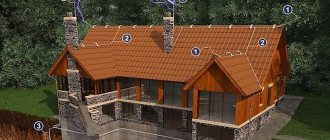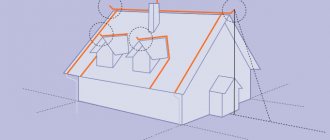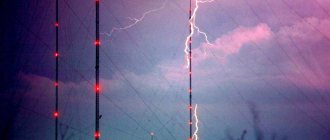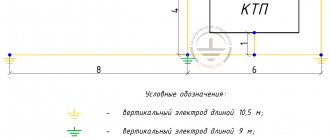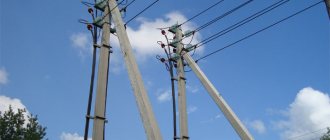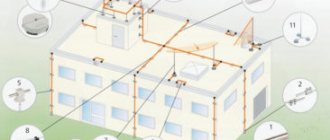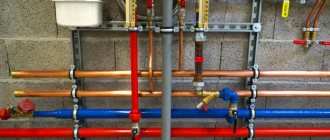Main components of protective systems
The main indicator of protective properties is the H/h ratio, in which the numerator is the distance from the beginning of the lightning discharge to the ground where this discharge will be directed. The denominator represents the height of the lightning rod itself. Calculation methods and determination of the boundaries of protective zones differ from each other, especially when double or multiple lightning rod designs are used.
A set of equipment designed to protect buildings and structures performs the function of capturing natural electrical discharges, conducting and transmitting them into the ground along specially laid paths and through a grounding loop. This ensures the protection of material assets and prevents their damage and destruction.
The standard protective complex consists of the following components:
- Lightning rod. This element is the very first to receive an electrical discharge. These devices are better known as lightning rods or lightning rods. Structurally, they are made of pointed metal rods, or they represent a mast or cable stretched horizontally along the ridge and along the perimeter of the roof.
- Down conductor. A metal conductor, fixed to external walls or at a distance from them, through which the high voltage current generated by a lightning discharge passes.
- Grounding. It is made of metal structures according to various schemes. They are buried in the ground based on precise engineering calculations. Connected to the down conductor, the ground loop transmits the discharge of electricity to the ground, and this completes the neutralization of the lightning strike.
Shark
It is also a multifunctional program that, in addition to calculating the grounding loop, will help calculate the lightning protection system, lighting wiring and other parameters of equipment and electrical networks. The advantages of this software include its simplicity and Russified interface. Just like the previous option, it can be used free of charge.
For the calculation, data on the resistance of the soil (taken into account by the type and thickness of the layer), horizontal and vertical electrodes is entered into the appropriate fields of the program.
The process of using the program is as follows:
- in the “Service” menu you need to select the “Create calculation module” option;
- indicate the type of module, in our case it is “Calculation of grounding devices”;
Shark program module creation
- Enter the required parameters in the appropriate fields and click the “Calculate” button
Types of lightning rods
Lightning protection systems for buildings can be implemented according to various schemes. Most often, classic options are used with rod lightning rods, consisting of rods connected to the ground loop with a special conductor. They are easy to manufacture and reliable during operation. In other designs, the main element is a spatial grid located on the roof of the building.
In the event of a direct lightning strike, it distributes and subsequently extinguishes the discharge. Tension systems work on the same principle as rod structures, only the receiving conductors are tensioned along the entire perimeter of the roof of the protected object.
The designs of the listed schemes use steel rods, cables or meshes made from a rod with a diameter of at least 6 mm. The connection of the nodes is carried out using welding. Tension protective lightning rods are used on roofs with complex configurations. A spatial grid requires more materials, and their installation is quite complex, requiring knowledge and practical skills.
Each lightning rod is selected individually. The design features of buildings and structures, their shape, size and location relative to each other are taken into account. Based on these data, lightning protection calculations are made. All such devices create a conditional protective zone adjacent to them on all sides.
Inside this space, all objects are protected and are not afraid of direct lightning strikes. Here a certain degree of reliability is ensured, divided into two types: A – 99.5% or more, B – 95% or more. The second option is usually used at agricultural sites.
ElectriCS Storm
It is a serious program for calculating a grounding device; it will also help to calculate the parameters of lightning protection and electromagnetic compatibility. It has a fairly comprehensive functionality for calculations and resulting data about objects. With its help, you can find out the grounding potential distribution during short circuits, the step voltage field in an emergency, and other values.
Diagram of voltage distribution during short circuit
Unlike previous versions, ElectriCS Storm is not suitable for use by beginners. To work in it you will need not only basic knowledge in the field of electrical engineering, but also the skills to use it in AutoCAD with three-dimensional modeling. What is relevant for professional designers involved in the construction of substations, boiler houses, pumping stations, package transformer stations and other facilities with powerful equipment and an extensive protective circuit.
ElectriCS Storm simulation example
The disadvantages of this program include the fairly high fee that users must pay for an activation key or a more advanced version that supports certain modules and updates.
How to calculate grounding in a private house manually
As you already understood, the main parameter that needs to be calculated is the total resistance to spreading, i.e. it is necessary to select such a configuration of electrodes so that the resistance of the grounding device does not exceed the standard one. According to the provisions of the rules for electrical installation devices (PEU), certain maximum currents must be observed:
- 2 Ohm - for 380 volts;
- 4 Ohm - for 220 volts;
- 8 Ohms - for 127 volts.
Correct calculation begins with calculating the optimal size and number of rods. To do this manually, the easiest way is to use the simplified formulas below.
- Ro – rod resistance, Ohm;
- L – electrode length, m;
- d – electrode diameter, m;
- T – distance from the middle of the electrode to the surface, m;
- peq – soil resistance, Ohm;
- ln — natural logarithm;
- π is a constant (3.14).
- Rн – standardized resistance of the grounding device (2, 4 or 8 Ohms).
- ψ – climatic correction factor for soil resistance (1.3, 1.45, 1.7, 1.9, depending on the zone).
Using these formulas, you can calculate the grounding device quite accurately, however, to simplify the calculation, some coefficients are omitted.
It is also very important that when choosing the depth and length of the grounding rods, the lower end passes below the freezing level, since at negative temperatures the soil resistance increases sharply, and certain difficulties arise.
Lightning rod and descent
As for the first component of lightning protection (lightning rod), the requirements of the PUE stipulate that it should be located at the highest point of the protected structure.
For standard pin-class structures, the location of this element is selected based on the fact that the pointed end of its peak is 2-3 meters above the plane or ridge of the roof.
If there are several pin lightning rods on the protected object, according to the generally accepted methodology, the distance between adjacent lightning rods must be calculated.
In the case of using a cable or mesh lightning rod, for the corresponding lightning protection elements, calculations are made of either the main parameters of the cable (length and cross-section) or the dimensions of an individual mesh cell.
It is not recommended to use longer lightning rods, since they will begin to attract even those lightning discharges that do not threaten the given object in any way.
A down conductor is necessary to redirect the electrical discharge received by the lightning rod in the direction of the grounding device. On the one hand, it is connected to the lightning “catcher”, and on the other, to the ground electrode structure.
Its main calculated values are the material of the outlet tape, its length and cross-section, which ensure the lowest electrical resistance of the outlet chain.
From the point of view of calculating the system, in order to achieve the required result, this element must be made of metals with high electrical conductivity and have a sufficiently large cross-section (usually 6-8 sq. mm).
Calculator elec.ru
A fairly convenient option for calculating grounding if you do not have time to install the program on your PC. This is an online calculator that, even with minimal Internet speed, will allow you to calculate the basic parameters of grounding conductors. To do this, you just need to go to the calculator page and enter the appropriate data in the fields of the site:
- limiting resistance value for grounding;
- characteristics of the soil in which it will be installed;
- parameters for vertical electrodes and horizontal connections;
Click the “Calculate” button and the parameters you are interested in will appear in the calculation data section.
Calculation program elec.ru
Grounding calculator on our website
Grounding calculation calculator asutpp.ru
It is also a pretty good version of an online program for calculating grounding. Here are the calculation methods by which the calculations are carried out. This is the most convenient option if you do not want to waste time and effort on installing programs, but need to perform mathematical operations urgently.
Compared to other options, this calculator has a convenient and intuitive interface; a number of important indicators are taken into account during the design, namely:
- layer-by-layer soil characteristics adjusted for climatic coefficient;
- ratio of the length of grounding conductors and contacting substances;
- number and sizes of electrodes for grounding.
To calculate, you just need to click the “Calculate” button, and on the screen you will see the most important factors for determining the parameters of future grounding. An important factor is the full compliance of the obtained parameters with the requirements established by regulatory documents. The calculation characteristics are also updated online - just restart the page and start new calculations.
You can go to this program using the link: https://www.asutpp.ru/raschet-zazemleniya.html
"Grounding" program
It is a fairly easy to use program. Grounding calculations in it are made on the basis of simple calculation algorithms. Even a beginner can easily understand the working field and the principle of its operation, so this program can be considered universal.
To start calculations you just need to enter:
- dimensions of vertical and horizontal grounding conductors;
- the method of their location and connection;
- climatic conditions in which grounding is operated;
- data on soil, network power.
By clicking the “Calculation” button, the data you are interested in will appear on the screen.
Working in the Grounding program
You can download this utility from the link on the official website: https://rzd2001.narod.ru/zz.html
Calculation of grounding devices
Like the previous option, this is also a relatively easy-to-use program for grounding calculations. In addition to the direction we are interested in, it also allows us to determine lightning protection parameters. The interface of this software during calculations also does not cause any difficulties in operations.
Calculation of grounding devices
To perform calculations, you must enter the following information in the program fields:
- standard value of resistance to electric current that can be obtained;
- the type of soil from which its resistivity is selected;
- climatic zone in which grounding will be installed;
- dimensional parameters of vertical and horizontal grounding conductors and method of their placement.
As a result of the program, the user receives the number of electrodes and the predicted resistance value.
Purpose and composition of the system
To protect buildings from lightning discharges, so-called “passive” lightning protection is most often used, consisting of such structural elements as:
- lightning rod, equipped in the form of a metal pin, cable or special mesh structure;
- a current collector (descent) used to redirect the discharge to a grounding device (GD);
- the grounding structure itself.
Next, the main parameters of the lightning protection system to be calculated will be considered.
Lightning protection of buildings, structures, equipment and communications
Atmospheric phenomena with the formation of lightning, accompanied by bright flashes of light and thunder, are called thunderstorms. Lightning is a thunderstorm discharge of electricity that occurs between clouds and the Earth; inside the clouds.
Lightning strikes a house
Danger to human life, the safety of industrial and public buildings, high-rise engineering structures - chimneys, television antennas, radio communications, including cellular; towers, electrical network supports; technological equipment located on open industrial sites, for example, for distillation columns of oil refining enterprises, lightning is of the first type.
The need for lightning protection is due to the fact that the voltage during lightning discharges reaches 50 million V, and the current strength - up to 100 thousand A; with the release of huge amounts of light, sound and thermal energy. Lightning discharges are electrical explosions, similar to detonation, causing destruction to buildings, breaking trees that served as grounding sources; injure and concuss people, which often leads to their death.
Lightning protection is a set of technical solutions that reliably ensure the safety of people, the protection of buildings for various purposes, and high-rise objects; technological and engineering equipment of production facilities; communications infrastructure of populated areas, power lines, both from direct impacts of lightning discharges, electromagnetic, electrostatic induction, and from the transmission of electric current through metal structures, communications.
Grounding and lightning protection are what, according to the standards, industrial buildings, utility lines, and other facilities must be equipped with. In addition, paragraph 4 of Article 50 of Federal Law of the Russian Federation No. 123-FZ prescribes, as one of the ways to eliminate ignition sources, to arrange lightning protection for buildings and equipment to increase the level of fire safety at facilities.
Standards for lightning protection devices
Considering that buildings, structures, technological installations, communications are quite different in their design and execution, state, departmental, and corporate standards have been developed; standards, design rules for organizing optimal, effective lightning protection for each type of facility - from industrial facilities, where it was first used, to residential buildings.
The standards that regulate the creation of technical protection against lightning are based on experience in organizing the electrical safety of buildings of various types and purposes, taking into account the features inherent in modern buildings, structures and communications infrastructure and communications.
Requirements for lightning protection are set out in many official documents. Design and calculation of lightning protection is carried out on the basis of the following regulatory and technical framework:
- "Rules for electrical installations." Currently, the seventh and some chapters of the sixth edition of this fundamental document are in effect, without knowledge of the requirements of which it is impossible to design any types, types of electrical installations, equipment, equipment for protection against electric shock, including lightning protection. Industrial safety of protected objects with categories of explosion and fire hazard of premises and buildings is also impossible without this type of protection from high-voltage electric discharges. This takes into account the requirements for the organization and implementation of lightning protection for various types of buildings, engineering structures, electrical communications, specified in several chapters of the PUE. Chapters 2.4, 2.5 - for overhead power lines with an operating voltage of less than and more than 1 kV, respectively, including a zoning map of the territory of Russia indicating the duration of thunderstorms per year, which is necessary when designing lightning protection systems and devices. Chapter 4.2 – for switchgears, electrical substations with voltages greater than 1 thousand V. Chapter 4.3 – for converter substations, installations.
- RD 34.21.122-87 “Instructions for the installation of lightning protection of buildings and structures.” Its purpose is clear from the name. Despite the fact that the document was approved by the Ministry of Energy of the Soviet Union, in agreement with the State Construction Committee, it is still in force today.
- Some of its provisions have inevitably become outdated, not keeping up with scientific and technological progress, therefore, when designing modern technical systems and lightning protection devices, they use Russian GOSTs, which are identical to the standards of the International Electrotechnical Commission; as well as domestic instructions on lightning protection, published later.
- One of these documents SO 153-34.21.122-2003, developed by the same team of scientists, regulates the design of lightning protection for both buildings and infrastructure communications.
- GOST R IEC 62305-1-2010, GOST R IEC 62305-2-2010, which are two parts of one national standard on risk management when protecting facilities from lightning. The first part formulates general principles, the second – methods for assessing the risks of death and injury from electric shock to people; complete/partial destruction of objects, public communications; economic losses from lightning strikes.
- It is important that such factors as fire safety are considered, since the calculations take into account spaces with a flammable environment - an air mixture of vapors of flammable liquids, gases, and dust.
- GOST R IEC 62561.1-2014. This is the first part of the national standard on elements of lightning protection systems, concerning requirements for their parts and connections.
- GOST R IEC 62561.2-2014 – to conductors, grounding electrodes.
- GOST R IEC 62561.3-2014 – for distribution arresters.
- GOST R IEC 62561.4-2014 – for fastening elements.
- GOST R IEC 62561.5-2014 – for inspection wells, seals of grounding electrodes.
Requirements for the design, grounding, lightning protection of electrical installations, building equipment, power lines in the USSR were also established by SNiP 3.05.06-85 on electrical devices. Today there is a set of rules in force, issued as its updated version - SP 76.13330.2016.
In addition to the standards in force on the territory of the Russian Federation, similar requirements for lightning protection systems applied in the allied states should be mentioned. In the Republic of Kazakhstan, this is SP RK 2.04-103-2013 on the design of lightning protection of objects, issued to replace a similar instruction SN RK 2.04-29-2005; in the Republic of Belarus - technical code TKP 336-2011 on lightning protection of objects and utilities.
Type of lightning protection zones
Lightning protection systems for objects, engineering, communications and technological equipment are understood as external and internal technical devices that allow them to be protected both from the direct impact of lightning strikes and from secondary impacts - electric, electromagnetic fields that accompany a lightning discharge.
There are active and passive lightning protection systems.
Passive , capable of intercepting lightning before it discharges on the structure of a construction site, equipment body or part of an engineering, communications structure, and discharging the charge into the ground, consists of the following elements:
- Lightning receiver.
- Lightning rods.
- Grounding devices.
In an active system, these integral elements are supplemented by devices that generate an upward flow of ions that attracts a lightning discharge.
Several types of lightning protection systems are designed and installed - rod, cable, which, based on the results of calculations, depending on the number of rods/cables, their arrangement/location, configuration of the protection area, can create two types of lightning protection zones:
- A. The degree of protection reliability is from 99.5%.
- B – from 95%.
Types of lightning protection systems
In practice, if a construction site, technological installation, tower, pole, utility antenna is completely located in the zone of protection from lightning strikes, the probability of them being damaged by a lightning electric discharge tends to zero.
Classification of buildings and structures by lightning protection device
There are the following categories of lightning protection for construction sites , depending on the purpose, significance, fire hazard class and the possibility of explosion; fire load – presence, quantity, type of explosive and fire hazardous materials; regional frequency of lightning discharges; recorded lightning strikes:
- Category I , which has the highest level of protection against a possible direct lightning strike on an object. These are production facilities with explosive zones of hazard classes B-I, II. Protection zone type – A.
- II category . These are industrial and warehouse buildings, open areas for storing flammable liquids, flammable liquids, and with technological equipment installed on them, where they are circulated; as well as explosive production, outdoor installations with hazard class below B-Ia. Type of protection zone for process equipment installed on open industrial sites – B; for objects - A or B, depending on the predicted number of lightning discharges per year.
- III category . This includes construction projects for various purposes with III–V degrees of fire resistance in areas where the annual duration of thunderstorms is more than 20 hours. The main type of lightning protection is B.
All the main parameters of the lightning protection system for any specific facility can be determined using Table 1 of RD 34.21.122.
Types of lightning protection
Depending on the category of objects, the lightning protection system can be of several types:
- Protects against direct impacts. The devices used for this are called lightning rods, consisting of a load-bearing support, which can be the building itself, a discharge receiver, a down conductor and a grounding conductor. Both rod and cable lightning rods and metal mesh laid on the roof of the protected object are used. For overhead power lines, lightning protection cables are used to absorb lightning strikes.
- From electrostatic induction. This is done by connecting all electrical equipment to the facility’s grounding system.
- From electromagnetic induction. To do this, conductive jumpers are installed at the junction points between sections of pipelines and overpasses.
- From the drift of electric potential caused by a lightning discharge. To do this, all communications entering buildings and structures, including the metal sheath of electrical cables with voltages up to 1 thousand V, are grounded. Overhead power lines at the approaches to the facility are equipped with lightning protection cables, and arresters and surge suppressors are mounted on the supports.
Means and methods of lightning protection
The means of protection against electrical lightning discharges include:
- rod lightning receivers;
- lightning protection cables;
- mesh lightning rods;
- down conductors;
- grounding contours of construction sites.
There are two types of lightning protection options:
- External, protecting from the direct impact of a high-potential electrical discharge that can cause destruction, explosions and fires, due to its discharge into the ground to dissipate energy.
- Interior. For protection against secondary factors of direct or close to the protected object lightning strike. For this purpose, various types of special devices are used, called SPDs - surge protection devices.
Lightning protection of a building
Installation of lightning protection and testing of lightning protection upon completion of installation work is carried out by organizations performing electrical work.
Operation of lightning protection does not require additional costs and is designed for a long period. But inspection of lightning protection for detection of mechanical damage to discharge receivers, current-carrying, grounding elements, and connections between them is still required.
Checking lightning protection allows facility owners, management of enterprises, and organizations to be confident that it will not fail during a dangerous thunderstorm period.
